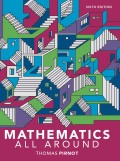
Concept explainers
a.
To find:
The majority of the candidate using the following condition,
| Molina | 2, 543 |
| Sobieski | 1, 532 |
| Wilson | 892 |
| Gambone | 473 |
Answer to Problem 1CT
Solution:
No, there is no candidate earns majority.
Explanation of Solution
Consider four candidates running for town council receive votes as follows:
| Molina | 2, 543 |
| Sobieski | 1, 532 |
| Wilson | 892 |
| Gambone | 473 |
Definition:
If n is even then the majority of voter is
If n is odd then the majority of voters is
Where n is the number of votes.
Approach:
From the given table the value of
Therefore, the majority of voters is given below,
Therefore, there is no voter pass this majority rule. Since no voter has greater than majority value.
So, there is no candidate earns majority.
b.
To find:
The winner of the election by using the plurality method.
Answer to Problem 1CT
Solution:
The winner of the election is Molina.
Explanation of Solution
Consider four candidates running for town council receive votes as follows:
| Molina | 2, 543 |
| Sobieski | 1, 532 |
| Wilson | 892 |
| Gambone | 473 |
Definition:
The Plurality Method:
Each person votes for his or her favorite candidate. The candidate receiving the most votes is declared the winner.
Approach:
From the above table the candidate Molina has most votes. So he is declared as the winner.
So, the winner of the election is Molina.
Want to see more full solutions like this?
Chapter 11 Solutions
Mathematics All Around (6th Edition)
- 8. For x>_1, the continuous function g is decreasing and positive. A portion of the graph of g is shown above. For n>_1, the nth term of the series summation from n=1 to infinity a_n is defined by a_n=g(n). If intergral 1 to infinity g(x)dx converges to 8, which of the following could be true? A) summation n=1 to infinity a_n = 6. B) summation n=1 to infinity a_n =8. C) summation n=1 to infinity a_n = 10. D) summation n=1 to infinity a_n diverges.arrow_forward8) Use the Venn diagram provided to shade An Bº. A B U Darrow_forward5) Describe the difference between disjoint sets and overlapping sets.arrow_forward
- 12) Suppose U = {a,b,c,d,e) and A = {a, b, c, e) and B = (c,d,e). Determine (An B).arrow_forward1) Use the roster method to list the elements of the set consisting of: a) All positive multiples of 3 that are less than 20. b) Nothing (An empty set).arrow_forward2) Let M = {all postive integers), N = {0,1,2,3... 100), 0= {100,200,300,400,500). Determine if the following statements are true or false and explain your reasoning. a) NCM b) 0 C M c) O and N have at least one element in common d) O≤ N e) o≤o 1arrow_forward
- 4) Which of the following universal sets has W = {12,79, 44, 18) as a subset? Choose one. a) T = {12,9,76,333, 44, 99, 1000, 2} b) V = {44,76, 12, 99, 18,900,79,2} c) Y = {76,90, 800, 44, 99, 55, 22} d) x = {79,66,71, 4, 18, 22,99,2}arrow_forward3) What is the universal set that contains all possible integers from 1 to 8 inclusive? Choose one. a) A = {1, 1.5, 2, 2.5, 3, 3.5, 4, 4.5, 5, 5.5, 6, 6.5, 7, 7.5, 8} b) B={-1,0,1,2,3,4,5,6,7,8} c) C={1,2,3,4,5,6,7,8} d) D = {0,1,2,3,4,5,6,7,8}arrow_forwardA smallish urn contains 25 small plastic bunnies – 7 of which are pink and 18 of which are white. 10 bunnies are drawn from the urn at random with replacement, and X is the number of pink bunnies that are drawn. (a) P(X = 5) ≈ (b) P(X<6) ≈ The Whoville small urn contains 100 marbles – 60 blue and 40 orange. The Grinch sneaks in one night and grabs a simple random sample (without replacement) of 15 marbles. (a) The probability that the Grinch gets exactly 6 blue marbles is [ Select ] ["≈ 0.054", "≈ 0.043", "≈ 0.061"] . (b) The probability that the Grinch gets at least 7 blue marbles is [ Select ] ["≈ 0.922", "≈ 0.905", "≈ 0.893"] . (c) The probability that the Grinch gets between 8 and 12 blue marbles (inclusive) is [ Select ] ["≈ 0.801", "≈ 0.760", "≈ 0.786"] . The Whoville small urn contains 100 marbles – 60 blue and 40 orange. The Grinch sneaks in one night and grabs a simple random sample (without replacement) of 15 marbles. (a)…arrow_forward
- Using Karnaugh maps and Gray coding, reduce the following circuit represented as a table and write the final circuit in simplest form (first in terms of number of gates then in terms of fan-in of those gates).arrow_forwardConsider the alphabet {a, b, c}.• Design a regular expression that recognizes all strings over {a, b, c} that have at least three nonconsec-utive c characters (two characters are non-consecutive if there is at least one character between them)and at least one a character.• Explain how your regular expression recognizes the string cbbcccac by clearly identifying which partsof the string match to the components of your regular expressionarrow_forwardComplex Analysis 2 z3+3 Q1: Evaluate cz(z-i)² the Figure. First exam 2024-2025 dz, where C is the figure-eight contour shown inarrow_forward
 Discrete Mathematics and Its Applications ( 8th I...MathISBN:9781259676512Author:Kenneth H RosenPublisher:McGraw-Hill Education
Discrete Mathematics and Its Applications ( 8th I...MathISBN:9781259676512Author:Kenneth H RosenPublisher:McGraw-Hill Education Mathematics for Elementary Teachers with Activiti...MathISBN:9780134392790Author:Beckmann, SybillaPublisher:PEARSON
Mathematics for Elementary Teachers with Activiti...MathISBN:9780134392790Author:Beckmann, SybillaPublisher:PEARSON
 Thinking Mathematically (7th Edition)MathISBN:9780134683713Author:Robert F. BlitzerPublisher:PEARSON
Thinking Mathematically (7th Edition)MathISBN:9780134683713Author:Robert F. BlitzerPublisher:PEARSON Discrete Mathematics With ApplicationsMathISBN:9781337694193Author:EPP, Susanna S.Publisher:Cengage Learning,
Discrete Mathematics With ApplicationsMathISBN:9781337694193Author:EPP, Susanna S.Publisher:Cengage Learning, Pathways To Math Literacy (looseleaf)MathISBN:9781259985607Author:David Sobecki Professor, Brian A. MercerPublisher:McGraw-Hill Education
Pathways To Math Literacy (looseleaf)MathISBN:9781259985607Author:David Sobecki Professor, Brian A. MercerPublisher:McGraw-Hill Education





